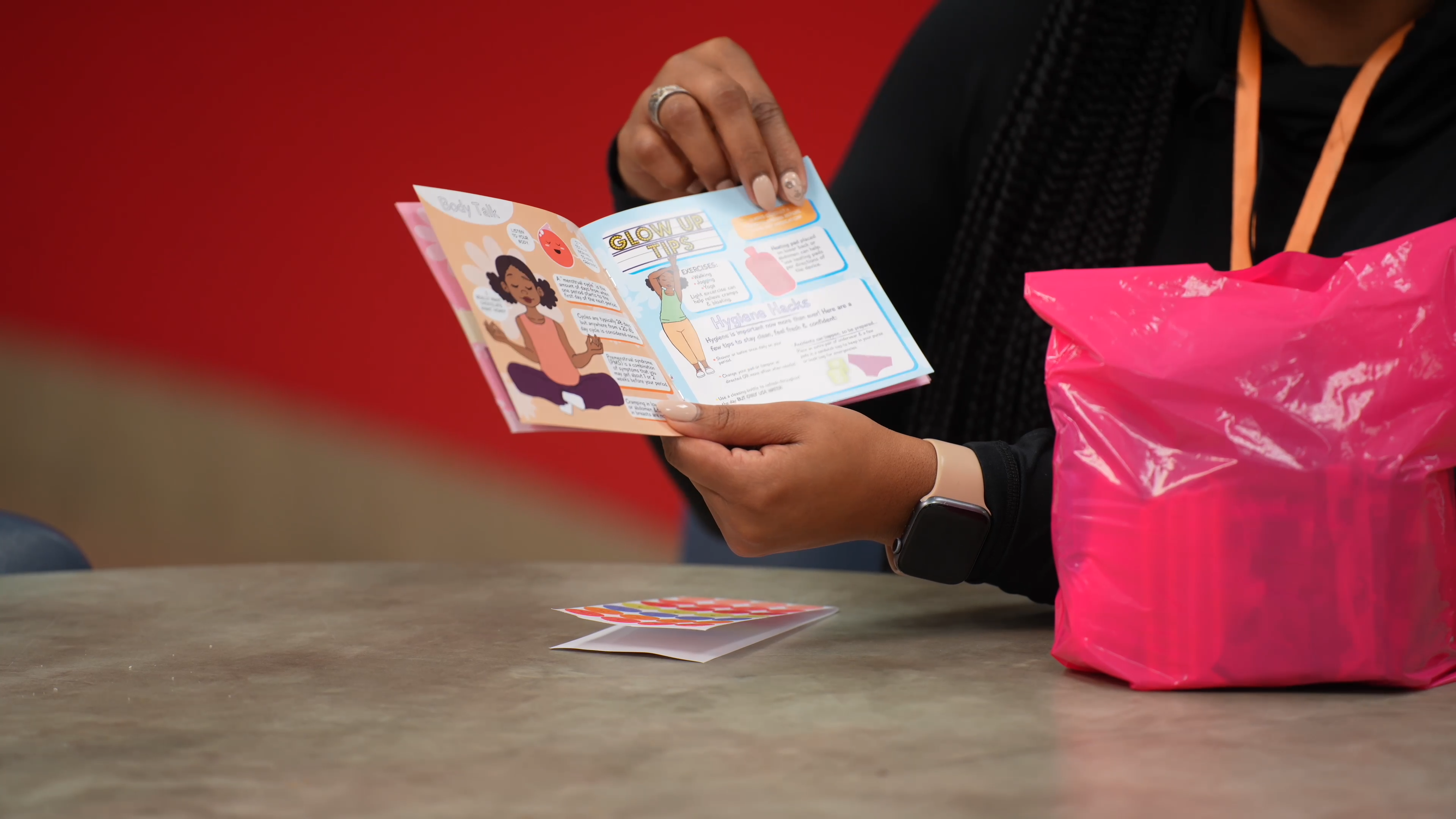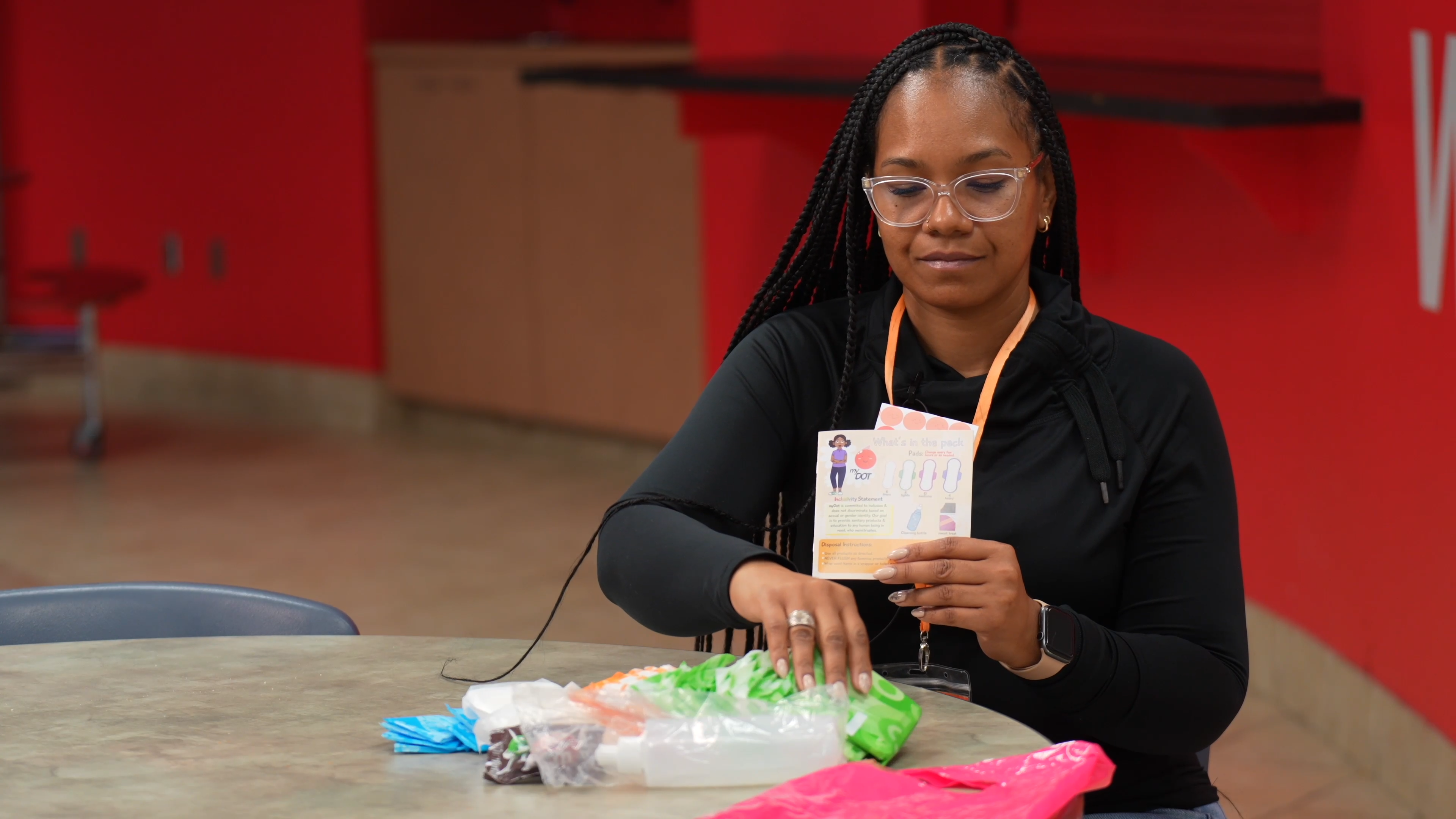About half of pre-teens – including some elementary students – will get an “unexpected visit from Aunt Flo,” otherwise known as a period.
Instead of leaving kids in the dark about “nature’s monthly visitor,” MyDOT prepares them for this life change by providing educational programming, access to free hygiene products and even creating a zine. The project uses art to spread its mission of fighting period poverty.
Period poverty happens when someone can’t afford and access menstrual products, hygiene facilities or awareness to manage their health. It also causes those who get periods to miss school, work and other commitments.
“Most teens are shocked when they get their first one,” Charity Pruitt, program manager for MyDOT, told Signal Cleveland. “I was in 5th grade when I got mine, so that’s why we try to start with students between 4th and 6th grade.”
More than 60% of menstruators said they struggled to afford products, according to a study from 2019. You can’t use food stamps to purchase tampons, pads or other “paper” products.
MyDOT puts together “pink packs” to try and bridge the gap between young people and the supplies they need during “that time of the month.” Each pink pack works as a period survival guide, including hygiene products and a myth-busting zine illustrated by Sequoia Bostick.
“When we first started handing these out in communities, people were like, ‘Oh my God, I wish this was around when I was a kid.’ It’s this, like, taboo thing,” Pruitt said. “We realized that it wasn’t just about the products, but the education and normalizing of it that needed to happen too.”
CollectivExpress provides a vehicle for MyDOT to thrive

Pruitt, who grew up in Cleveland Heights, said her family always stressed the importance of community-focused work. Her brother, Josiah Britt, started CollectivExpress to empower communities through artistic expression and engagement.
Although the idea for MyDOT sparked with Pruitt, CollectivExpress created the vehicle. Literally.
“It’s basically like the Polar Express, right? It’s the expression and ‘express’ like we will travel to you,” Britt said.
For about eight years, CollectivExpress has provided a layer of arts on top of social service programming and ensuring that community members can access the resources they need.
“We’re trying to get products where it’s needed most,” said Britt. “That’s primarily Black and brown or low-income communities, a lot of which you’ll find on the East Side of Cleveland.”
Since the program’s launch, MyDOT has circulated about 3,500 “pink packs,” according to Britt. The program has also teamed up with the Cleveland Department of Public Health, CMSD and other organizations to get menstrual supplies to anyone who needs them.
What’s in a “pink pack?”
- 6 liners
- 4 light pads
- 10 medium pads
- 4 heavy pads
- 1 cleansing bottle
- 1 sweet treat
- 1 zine/period tracker with sticker sheet
To request supplies, fill out the contact form on MyDOT’s website.
MyDOT looks to bust menstruation myths, period

Although most period education only focuses on girls, MyDOT is there for anyone who menstruates, regardless of their gender identity.
“You can’t put everybody in one bucket. This product needs to get exactly where it needs to get to, so we should not create additional barriers,” Pruitt said.
As part of CollectivExpress, MyDOT launched a zine to amplify its art-based mission, according to Britt. The nonprofit’s board is made up of nurse practitioners and other women’s healthcare professionals who helped steer the educational component of the project.
“We wanted the zine to bust myths and be attractive to young people,” Pruitt said. That’s when they pulled in Bostick, the local illustrator. Together, they designed the look of the zine and even created a round red mascot named Dot. When the girl asks questions, Dot is there to eliminate confusion and stigma around periods.

The zine also doubles as a period tracker, including colorful stickers to monitor symptoms such as mood changes and even the period itself. Pruitt said that she spent a lot of time thinking about how to make it fun. Each zine comes with a pack of emoji-inspired stickers.
MyDOT tries to catch kids before middle school, as some kids get their periods as early as eight years old. Although the average age ranges from 12 to 15, it can be hard to predict when Aunt Flo will make her first visit.
In partnership with CMSD, Pruitt said she goes into schools to hand out pink packs and teach students about period health. MyDOT has also made appearances at Boys & Girls Clubs and other places across the city to try and close the period poverty gap.
When asked what makes CollectivExpress stand out amongst other arts nonprofits, Britt said: “Any space that we find people are doing a great job, we want to get out of. Our job is to innovate and find groups that are not being served. That’s where we try to stay.”

Suggested Reading
With great power comes great responsibility: Spider-Man snags the youth vote in Cuyahoga County mock election
The Cuyahoga County Board of Elections set up a mock election for anyone under 16 years old to vote on their favorite princesses, superheroes and more.
Kids from New Era Cleveland tell adults to ‘get it together’ on gun safety
Two young leaders from New Era Cleveland’s Kids Safe Zone Academy explain how adults can better support kids traumatized by gun violence.
On the go-rilla: Cleveland Zoo gives update on new home for primates
Cleveland Zoo representatives updated the Metroparks board on plans to renovate its RainForest attraction ahead of its 150th anniversary in 2032.




